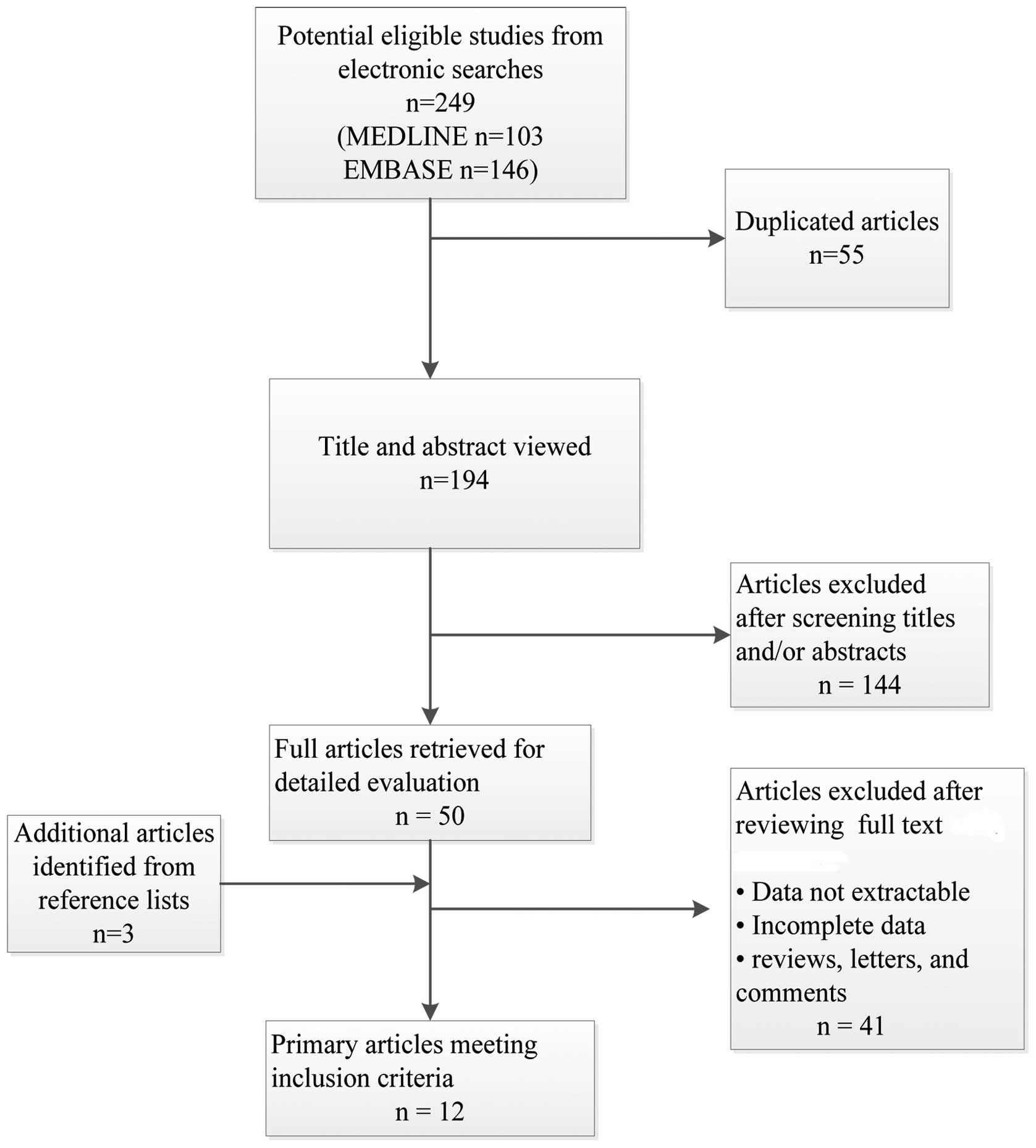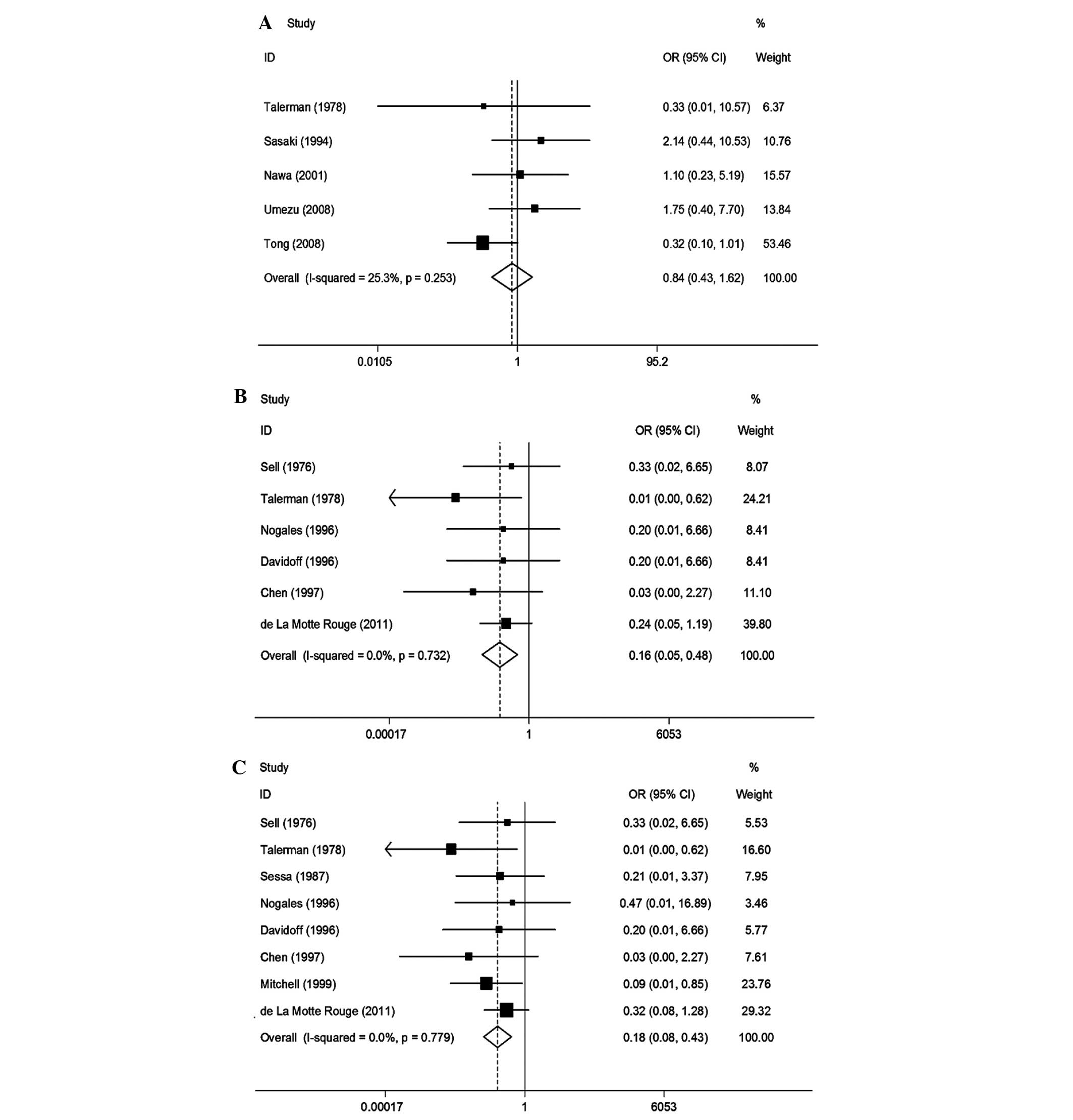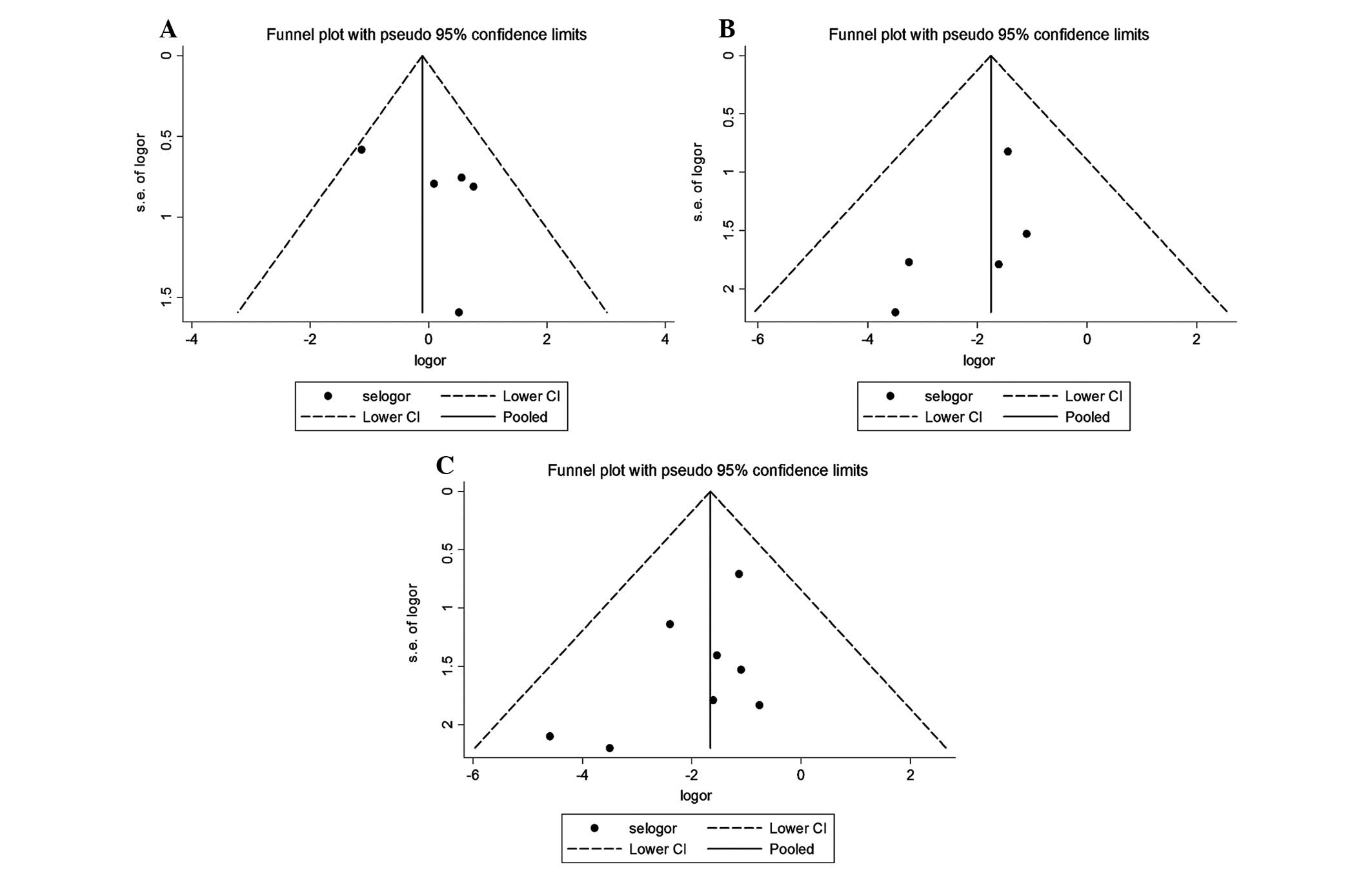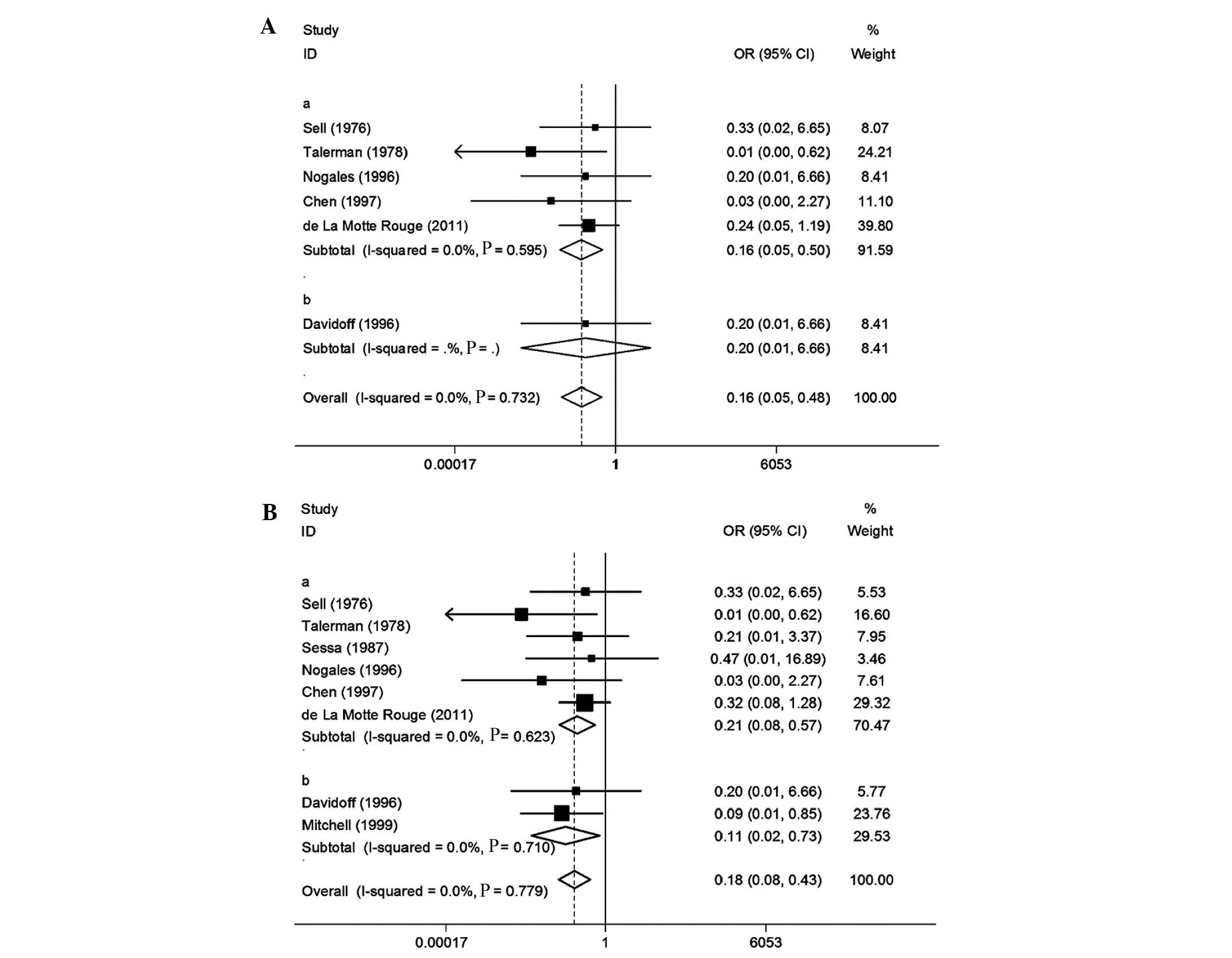Prognostic value of serum α‑fetoprotein in ovarian yolk sac tumors: A systematic review and meta‑analysis
- Authors:
- Published online on: September 18, 2014 https://doi.org/10.3892/mco.2014.417
- Pages: 125-132
Abstract
Introduction
Ovarian yolk sac tumor (OYST), also referred to as ovarian endodermal sinus tumor, is a rare malignant tumor typically occurring in adolescent and young adult women. OYSTs comprise ~1% of ovarian malignancies (1,2). In addition, OYST is a highly malignant germ cell tumor, characteristically expressing α-fetoprotein (AFP). AFP is a useful tumor marker for detecting malignancies such as hepatocellular carcinoma, yolk sac tumor and a specific type of gastric carcinoma. An elevated serum AFP level is usually detected in patient with OYST and may facilitate diagnosis (2).
The prognosis of OYST was extremely dismal in the past (3,4). Over the last few decades, with the introduction of novel combination chemotherapy, the prognosis of OYST has significantly improved; however, its prognosis remains unsatisfactory. Furthermore, little is known regarding the prognostic factors of OYST, due to the rarity of this type of tumor. The number of studies that have analyzed the prognostic factors of OYST is currently limited, while the rare published series on OYST usually include <50 cases (2,3,5–7). Certain studies presented evidence of the association between serum AFP level and the prognosis of OYST. Mitchell et al (8) reported that a shorter relapse-free survival (RFS) was primarily observed among patients with AFP >1,000 kU/l compared to that among patients with AFP ≤1,000 kU/l [odds ratio (OR)=0.09, 95% confidence interval (CI): 0.01–0.85]. In addition, de La Motte Rouge et al (9) demonstrated that there was a significant association between high serum AFP levels and 5-year overall survival (OS) of OYST (OR=0.24; 95% CI: 0.05–1.19). By contrast, other studies failed to demonstrate that AFP was a prognostic factor in patients with OYST (1,6,10).
Therefore, the objective of the present study was to perform a meta-analysis of the association between serum AFP levels and the prognosis of OYST.
Materials and methods
Literature search
A systematic review of original articles analyzing the prognostic value of AFP for OYST was performed through searching MEDLINE (1946 to August, 2013) and EMBASE (1980 to August, 2013). The search terms used were ‘ovarian neoplasm’, ‘ovarian masses’, ‘ovarian lesions’ and ‘alpha fetoprotein/AFP’, combined with the MeSH term ‘prognosis’ (disease-free survival, relapse-free survival, overall survival, progression-free survival, medical futility, neoplasm grading, neoplasm staging, nomograms, pregnancy outcome, treatment outcome and treatment failure). The search was limited to human studies and reports in languages other than English were excluded. Moreover, the reference lists of the available studies were reviewed to identify additional relevant citations. The study selection process is summarized in Fig. 1.
Inclusion criteria
The inclusion criteria were as follows: i) pathological diagnosis of YST or mixed YST; ii) serum AFP level was obtained; iii) original article published in English; and iv) survival data obtained, with ≥12 months of follow-up.
Exclusion criteria
The exclusion criteria were as follows: i) incomplete data; ii) animal studies; iii) duplicate studies; iv) reviews, letters and comments; v) low-quality articles; and vi) results presented as abstracts only.
Data extraction
English articles meeting the inclusion criteria were regularly assessed by pairs of reviewers. Any differences were discussed until the two reviewers reached a consensus. We recorded publication reference, tumor types (OYST or other tumors), mean patient age, study design, statistical techniques, country, total number of participants, characteristics of AFP, outcome reported (OS and RFS), mean follow-up and confounding factors. The characteristics of the studies included in this meta-analysis are summarized in Table I and detailed data for each study are provided in Table II.
Exposure measurements
We recorded the characteristics of AFP, including value, types and standard classification from each study and classified different groups according to the characteristics of AFP among studies. Certain studies reported on preoperative or postoperative AFP level for each patient, whereas others reported the total number of patients in each group, divided by preoperative or postoperative AFP level. We calculated the OR of higher vs. lower AFP level by comparing the outcomes in the two groups. The standard of higher and lower AFP level was based on the respective standard from each study.
Study quality
The quality of each study was assessed using a subset of items from Quality Assessment of Diagnostic Accuracy Studies 2 (19). We estimated the criteria as follows: type of study design, patient selection by diagnostic protocol, exposure measurement (characteristics of AFP, comparability of measurement across the study groups, follow-up time, validity and reliability of the measurement method), statistical analysis (appropriateness) and adjustment for key confounders (primary surgery and combination chemotherapy).
Statistical analysis
Pooled ORs of AFP level with 95% CIs for OS and RFS were obtained using the fixed- or random-effects models. The Q and I2 statistics were used to assess heterogeneity, where P≤0.05 or I2>50% were considered to indicate significant heterogeneity. When the result of the Q-test and I2 statistics suggested heterogeneity (P≤0.05 and I2>50%), a random-effects model was used. We used either fixed- or random-effects models in pooled estimates. Furthermore, we preferentially presented a random-effects model when heterogeneity was present. We also created forest plots for the ORs from each of the studies included in the meta-analysis and the estimation of the pooled OR. The sizes of the markers of each OR in the plots indicated the relative weight each study contributed to the pooled estimation. Publication bias was estimated by funnel plots, Begg's test and a weighted Egger's test (20). In addition, we produced sensitivity analyses, whereby each study was omitted in turn, reevaluating the pooled estimates under particular conditions. All the analyses were performed using STATA software, version 12.0 (StataCorp LP, College Station, TX, USA).
Results
Study characteristics
This meta-analysis included 12 studies reporting on 19 independent estimates. There were 320 participants from 9 different countries (3 studies from Japan, 2 from China and 1 each from Denmark, Holland, Italy, Spain, America, France and United Kingdom). Five studies reported preoperative AFP and OS; OS was assessed by 2- (n=1), 3- (n=1) and 5-year OS (n=3). Six studies reported postoperative AFP and OS; OS was assessed by 1- (n=3), 2- (n=2) and 5-year OS (n=1). Eight studies reported postoperative AFP and RFS; RFS was assessed by 1- (n=3), 2- (n=4) and 5-year RFS (n=1). The follow-up time ranged between 14 and 71 months.
Association between preoperative AFP and OS in OYST
We conducted a meta-analysis for 5 studies on preoperative AFP and OS (Table II). Heterogeneity tests revealed no evidence of heterogeneity among studies (Q=5.35, P=0.253, I2=25.3%). Therefore, the fixed-effects model was used to calculate a pooled OR with 95% CI. We failed to identify a correlation of preoperative AFP with OS (OR=0.84, 95% CI: 0.43–1.62) in OYST. A forest plot is shown in Fig. 2A. A funnel plot is shown in Fig. 3A and it exhibits near symmetry. The Begg's and Egger's tests indicated that publication bias was unlikely (Zc=0.73, P=0.462; t=1.24, P=0.303). A sensitivity analysis demonstrated that the results for preoperative AFP and OS in these studies were not robust, due to the Umezu et al (18) study, which exhibited significant heterogeneity (Table III).
Association between postoperative AFP and OS in OYST
Six studies were included (Table II). Heterogeneity tests revealed no evidence of heterogeneity among studies (Q=2.79, P=0.732, I2=0.0%); therefore, the fixed-effects model was used to assess a pooled OR with 95% CI. We observed that a high postoperative AFP level was associated with a decrease in OS (OR=0.16, 95% CI: 0.05–0.48). A high postoperative AFP level was associated with a worse OS compared to a low postoperative AFP level in patients with OYST. A forest plot is shown in Fig. 2B. A funnel plot is shown in Fig. 3B and it exhibits near symmetry. The Begg's and Egger's tests indicated that publication bias was unlikely in the meta-analysis on association between postoperative AFP and OS in these studies (Zc=1.31, P=0.189; t=-1.47, P=0.217). A sensitivity analysis demonstrated that the pooled estimate of the effect of postoperative AFP level on the risk of OS was robust, as shown in Table III.
Association between postoperative AFP and RFS in OYST
We performed a meta-analysis of 8 studies on postoperative AFP and RFS (Table II). Heterogeneity tests revealed no evidence of heterogeneity among studies (Q=4.01, P=0.779, I2=0.0%); therefore, the fixed-effects model was used to estimate a pooled OR with 95% CI. We observed that a high postoperative AFP level was associated with a decrease in RFS (OR=0.18, 95% CI: 0.08–0.43). A high postoperative AFP level was associated with a worse RFS compared to low postoperative AFP level in patients with OYST. A forest plot is shown in Fig. 2C. A funnel plot is shown in Fig. 3C and it exhibits near symmetry. The Begg's and Egger's tests indicated that publication bias was unlikely in the meta-analysis on association between postoperative AFP and RFS in these studies (Zc=1.11, P=0.266; t=-1.61, P=0.159). A sensitivity analysis demonstrated that the result was robust, as shown in Table III.
Subgroup analysis of postoperative AFP and OS
We conducted a meta-analysis of 8 studies on postoperative AFP and OS (Table IV). Heterogeneity tests revealed no evidence of heterogeneity among studies (Q=2.78, P=0.595, I2=0.0%); therefore, the fixed-effects model was used to calculate a pooled OR with 95% CI. In the design that was used, a high postoperative AFP level was associated with a decrease in OS (OR=0.16, 95% CI: 0.05–0.50). A postoperative AFP level of >1,000 ng/ml was associated with a worse OS compared to an AFP level of ≤1,000 ng/ml in patients with OYST. A forest plot is shown in Fig. 4A. The Begg's and Egger's tests indicated that publication bias was unlikely in the meta-analysis of the association between postoperative AFP and OS in these studies (Zc=1.22, P=0.221; t=-1.48, P=0.236).
Subgroup analysis of postoperative AFP and RFS
Eight studies were included (Table IV). Heterogeneity tests revealed no evidence of heterogeneity among studies (Q=3.50, P=0.623, I2=0.0%); therefore, the fixed-effects model was used to calculate a pooled OR with 95% CI. In the design that was used, a high postoperative AFP level was associated with a decrease in RFS (OR=0.21, 95% CI: 0.08–0.57). A postoperative AFP level of >1,000 ng/ml was associated with a worse RFS compared to an AFP level of ≤1,000 ng/ml in patients with OYST. A forest plot is shown in Fig. 4B. The Begg's and Egger's tests indicated that publication bias was unlikely in the meta-analysis on the association between postoperative AFP and RFS in these studies (Zc=1.11, P=0.266; t=-1.61, P=0.159).
Discussion
OYST is a rare malignancy, occurring most commonly in young women. AFP is an important tumor marker of yolk sac tumors. Moreover, an elevation of the serum AFP level is usually detected in patient with YST and is correlated with the severity of the disease. Due to the extreme sensitivity of AFP in diagnosing recurrence, the follow-up of the patients mainly includes measuring AFP levels (2).
Our study demonstrated that preoperative AFP was not a prognostic factor in patients with OYST. We failed to identify a correlation between preoperative AFP level and OS (OR=0.84, 95% CI: 0.43–1.62) in OYST, which may be due to the fact that preoperative AFP levels may only reflect the condition of the primary disease, but have a limited impact on patient outcome. Surgical resection of the tumor and chemosensitivity may be key to a successful treatment in patients with OYST. It is generally considered that the initial therapy for the majority of the patients should be a surgical intervention with comprehensive staging, so that a histological diagnosis and appropriate staging may be obtained (1,6). Tumor stage and the amount of residual tumor significantly affect prognosis. Certain authors have reported that tumor stage is a significant prognostic factor (3,21,22). Over the last few decades, fertility-sparing surgery has been the standard management of patients desiring fertility preservation, regardless of disease stage. Conservative surgery was not shown to affect the survival figures (10,23,24).
OYSTs are characterized by a high malignant potential, but are also highly chemosensitive. It was reported that 3 courses of bleomycin, etoposide and cisplatin (BEP) was the current standard adjuvant therapy, with 4 courses of BEP recommended in case of bulky residual disease following surgery (8,25,26). An effective postoperative chemotherapy regimen (BEP regimen) following surgery is a prognostic factor at least as significant as stage in these chemosensitive tumors (27). Our meta-analysis demonstrated that postoperative AFP was a prognostic factor in patients with OYST. Postoperative AFP was found to be correlated with OS and RFS. A high postoperative AFP level was associated with a worse OS (OR=0.16, 95% CI: 0.05–0.48) and RFS (OR=0.18, 95% CI: 0.08–0.43) compared to a low postoperative AFP level in patients with OYST, possibly because a high AFP level postoperatively suggests that the tumor was not completely resected. A number of factors may lead to incomplete tumor resection, such as inappropriate surgical approach, high degree of tumor invasion and metastatic spread. In general, patients with more residual tumor will exhibit higher postoperative AFP levels. Moreover, the amount of residual tumor was shown to be a significant prognostic factor (1,6).
To date, we demonstrated that high postoperative AFP levels were associated with worse OS and RFS compared to low postoperative AFP levels in patients with OYST. According to the groups from all studies that were divided by AFP level (>1,000 vs. ≤1,000 ng/ml), except in the studies by Davidoff et al (16) and Mitchell et al (8), we performed a subgroup analysis and observed that a postoperative AFP level of >1,000 ng/ml was associated with a decrease in OS (OR=0.16, 95% CI: 0.05–0.50) and RFS (OR=0.21, 95% CI: 0.08–0.57). A postoperative AFP level of >1,000 ng/ml was associated with a worse OS and RFS compared to an AFP level of ≤1,000 ng/ml in patients with OYST. Accordingly, we concluded that postoperative AFP level >1,000 ng/ml was associated with poor prognosis in patients with OYST.
The sensitivity analysis demonstrated that the results for preoperative AFP and OS were not robust, as the study by Umezu et al (18) exhibited significant heterogeneity. However, the Umezu et al (18) study did not affect the overall results. Furthermore, the results for postoperative AFP and outcome were robust.
A number of factors, which were difficult to evaluate, may influence the effect estimates, such as sample size, study design, characteristics of AFP, outcomes and duration of follow-up. Of note, there was no heterogeneity among the studies we observed using statistical analysis. Additionally, an almost symmetric inverted funnel shape was displayed by all the studies, indicating that publication bias was unlikely.
There were several limitations to our meta-analysis. First, due to the rarity of this type of tumor, our research included only a limited amount of cases and discussed two types of OYST (pure and mixed OYST) rather than a single type (pure OYST). Mixed OYSTs exhibit different biological or clinical characteristics compared to pure OYSTs, which may affect the results. More data are required to determine the similarities and differences between pure and mixed OYSTs. Second, the determination of a high AFP level standard (>1,000 ng/ml) in our study was dependent on a single measurement (which was used in most studies). This standard may be inaccurate. In the future, a more accurate standard must be determined based on accumulation of research data.
In conclusion, OYST is a rare malignancy encountered in young women and AFP is a useful tumor marker for detecting OYST. The postoperative, but not the preoperative, AFP level was found to be a prognostic factor in patients with OYST. High postoperative AFP levels were associated with a decrease in OS and RFS. In particular, a postoperative AFP level of >1,000 ng/ml was associated with a worse OS and RFS compared to an AFP level of ≤1,000 ng/ml in patients with OYST. Therefore, a postoperative AFP level of >1,000 ng/ml was identified as an indicator of poor prognosis in patients with OYST.
Acknowledgements
This study was supported by the Natural Science Foundation of Zhejiang Province of China (grant no. Y2100593).
Glossary
Abbreviations
Abbreviations:
|
AFP |
α-fetoprotein |
|
OYST |
ovarian yolk sac tumor |
|
OS |
overall survival |
|
OR |
odds ratio |
|
CI |
confidence interval |
|
RFS |
relapse-free survival |
|
BEP |
bleomycin, etoposide and cisplatin |
References
|
Kawai M, Kano T, Furuhashi Y, et al: Prognostic factors in yolk sac tumors of the ovary. A clinicopathologic analysis of 29 cases. Cancer. 67:184–192. 1991. View Article : Google Scholar : PubMed/NCBI | |
|
Dallenbach P, Bonnefoi H, Pelte MF and Vlastos G: Yolk sac tumours of the ovary: an update. Eur J Surg Oncol. 32:1063–1075. 2006. View Article : Google Scholar : PubMed/NCBI | |
|
Kurman RJ and Norris HJ: Endodermal sinus tumor of the ovary: a clinical and pathologic analysis of 71 cases. Cancer. 38:2404–2419. 1976. View Article : Google Scholar : PubMed/NCBI | |
|
Jimerson GK and Woodruff JD: Ovarian extraembryonal teratoma. I. Endodermal sinus tumor. Am J Obstet Gynecol. 127:73–79. 1977.PubMed/NCBI | |
|
Ayhan A, Taskiran C, Bozdag G, Altinbas S, Altinbas A and Yuce K: Endodermal sinus tumor of the ovary: the Hacettepe University experience. Eur J Obstet Gynecol Reprod Biol. 123:230–234. 2005. View Article : Google Scholar : PubMed/NCBI | |
|
Nawa A, Obata N, Kikkawa F, et al: Prognostic factors of patients with yolk sac tumors of the ovary. Am J Obstet Gynecol. 184:1182–1188. 2001. View Article : Google Scholar : PubMed/NCBI | |
|
Gershenson DM, Del Junco G, Herson J and Rutledge FN: Endodermal sinus tumor of the ovary: the M.D. Anderson experience. Obstet Gynecol. 61:194–202. 1983.PubMed/NCBI | |
|
Mitchell PL, Al-Nasiri N, A'Hern R, et al: Treatment of nondysgerminomatous ovarian germ cell tumors: an analysis of 69 cases. Cancer. 85:2232–2244. 1999. View Article : Google Scholar : PubMed/NCBI | |
|
de La Motte Rouge T, Pautier P, Rey A, et al: Prognostic factors in women treated for ovarian yolk sac tumour: a retrospective analysis of 84 cases. Eur J Cancer. 47:175–182. 2011.PubMed/NCBI | |
|
Tong X, You Q, Li L, et al: Prognostic factors of patients with ovarian yolk sac tumors: a study in Chinese patients. Onkologie. 31:679–684. 2008. View Article : Google Scholar : PubMed/NCBI | |
|
Sell A, Sogaard H and Norgaard-Pedersen B: Serum alpha-fetoprotein as a marker for the effect of post-operative radiation therapy and/or chemotherapy in eight cases of ovarian endodermal sinus tumour. Int J Cancer. 18:574–580. 1976. View Article : Google Scholar | |
|
Talerman A, Haije WG and Baggerman L: Serum alpha fetoprotein (AFP) in diagnosis and management of endodermal sinus (yolk sac) tumor and mixed germ cell tumor of the ovary. Cancer. 41:272–278. 1978. View Article : Google Scholar : PubMed/NCBI | |
|
Sessa C, Bonazzi C, Landoni F, Pecorelli S, Sartori E and Mangioni C: Cisplatin, vinblastine, and bleomycin combination chemotherapy in endodermal sinus tumor of the ovary. Obstet Gynecol. 70:220–224. 1987.PubMed/NCBI | |
|
Sasaki H, Furusato M, Teshima S, et al: Prognostic significance of histopathological subtypes in stage I pure yolk sac tumour of the ovary. Br J Cancer. 69:529–536. 1994. View Article : Google Scholar : PubMed/NCBI | |
|
Nogales FF, Bergeron C, Carvia RE, Alvaro T and Fulwood HR: Ovarian endometrioid tumors with yolk sac tumor component, an unusual form of ovarian neoplasm. Analysis of six cases. Am J Surg Pathol. 20:1056–1066. 1996. View Article : Google Scholar : PubMed/NCBI | |
|
Davidoff AM, Hebra A, Bunin N, Shochat SJ and Schnaufer L: Endodermal sinus tumor in children. J Pediatr Surg. 31:1075–1079. 1996. View Article : Google Scholar : PubMed/NCBI | |
|
Chen RJ, Huang SC, Chow SN, Hsieh CY, Lin MC and Hsu HC: Influence of chemotherapy or liver metastasis on the immunoelectrophoretic discrimination of alpha-fetoprotein from yolk sac tumor. Int J Gynecol Cancer. 7:486–489. 1997. View Article : Google Scholar | |
|
Umezu T, Kajiyama H, Terauchi M, et al: Long-term outcome and prognostic factors for yolk sac tumor of the ovary. Nagoya J Med Sci. 70:29–34. 2008.PubMed/NCBI | |
|
Whiting PF, Rutjes AW, Westwood ME, et al: QUADAS-2: a revised tool for the quality assessment of diagnostic accuracy studies. Ann Intern Med. 155:529–536. 2011. View Article : Google Scholar : PubMed/NCBI | |
|
Egger M, Davey Smith G, Schneider M and Minder C: Bias in meta-analysis detected by a simple, graphical test. BMJ. 315:629–634. 1997. View Article : Google Scholar : PubMed/NCBI | |
|
Gershenson DM, Del Junco GD, Copeland LJ and Rutledge FN: Mixed germ cell tumors of the ovary. Obstet Gynecol. 64:200–206. 1984.PubMed/NCBI | |
|
Morris HH, La Vecchia C and Draper GJ: Endodermal sinus tumor and embryonal carcinoma of the ovary in children. Gynecol Oncol. 21:7–17. 1985. View Article : Google Scholar : PubMed/NCBI | |
|
Bakri YN, Ezzat A, Akhtar, Dohami and Zahrani: Malignant germ cell tumors of the ovary. Pregnancy considerations. Eur J Obstet Gynecol Reprod Biol. 90:87–91. 2000. View Article : Google Scholar : PubMed/NCBI | |
|
Low JJ, Perrin LC, Crandon AJ and Hacker NF: Conservative surgery to preserve ovarian function in patients with malignant ovarian germ cell tumors. A review of 74 cases. Cancer. 89:391–398. 2000. View Article : Google Scholar : PubMed/NCBI | |
|
Williams S, Blessing JA, Liao SY, Ball H and Hanjani P: Adjuvant therapy of ovarian germ cell tumors with cisplatin, etoposide, and bleomycin: a trial of the Gynecologic Oncology Group. J Clin Oncol. 12:701–706. 1994.PubMed/NCBI | |
|
Gershenson DM, Morris M, Cangir A, et al: Treatment of malignant germ cell tumors of the ovary with bleomycin, etoposide, and cisplatin. J Clin Oncol. 8:715–720. 1990.PubMed/NCBI | |
|
Cicin I, Saip P, Guney N, et al: Yolk sac tumours of the ovary: evaluation of clinicopathological features and prognostic factors. Eur J Obstet Gynecol Reprod Biol. 146:210–214. 2009. View Article : Google Scholar : PubMed/NCBI |













